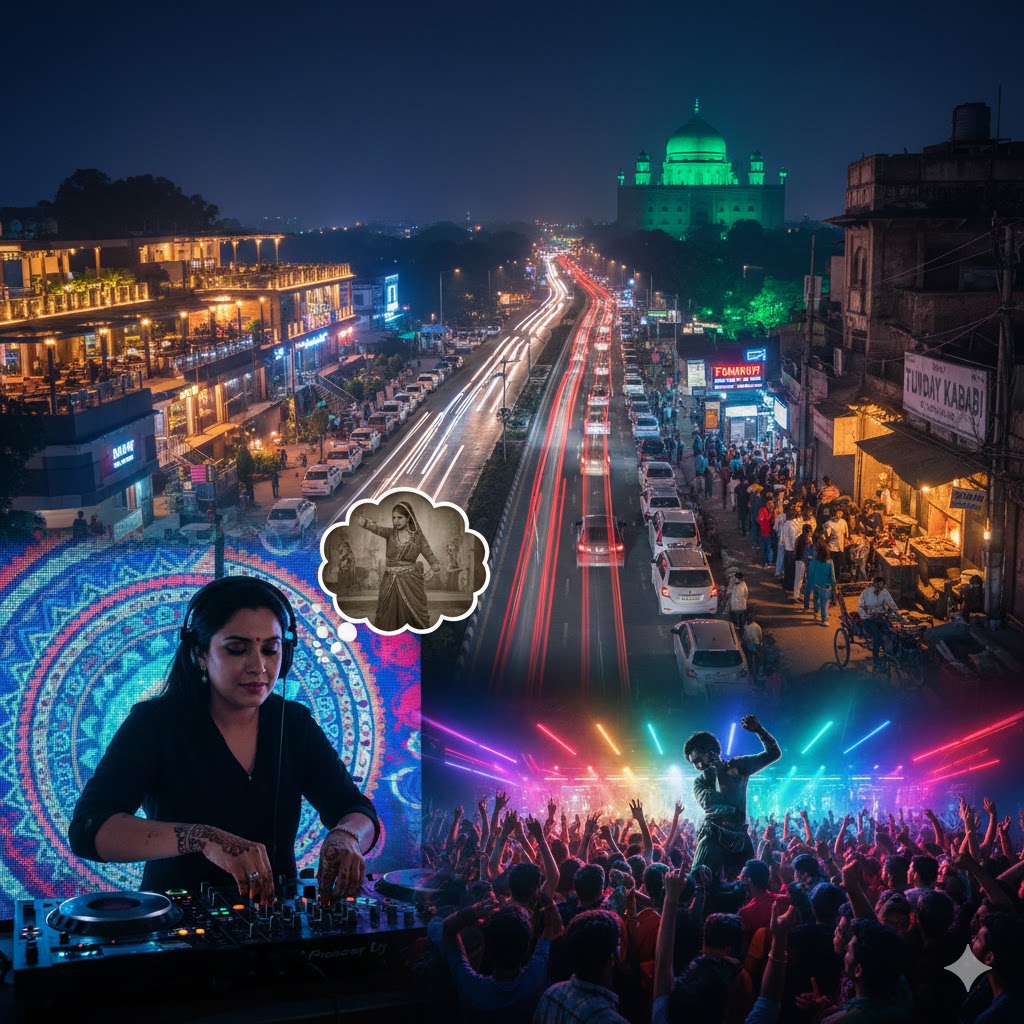Lucknow: In the labyrinthine streets of Lucknow, where the air carries whispers of Awadhi poetry and the aroma of kebabs, Hazratganj stands as a living monument to the city’s syncretic soul. Named after Prince Mirza Hazrat, son of Nawab Asaf-ud-Daula, this bustling market district emerged in the 19th century as a colonial-era enclave, blending Victorian architecture with Mughal grandeur. For nearly two centuries, it was the city’s social and commercial epicenter. Yet, decades of unchecked urbanization had dulled its luster: encroachments choked its alleys, haphazard signboards clashed with its heritage…
Read MoreCategory: Travel
Lucknow After Dark: When the City of Nawabs Learns to Dance
Lucknow: Lucknow goes to bed early, or so the old saying claims. The kebab shops roll down their shutters by eleven, the paanwallahs wipe their counters, and the grand gates of Hazratganj’s colonial façades seem to yawn shut. Yet the moment the last azaan fades from the minarets, the city changes its skin. A second Lucknow awakens—one that the 19th-century chroniclers never imagined and the 21st-century guidebooks still struggle to describe. It is younger, louder, and deliciously unapologetic. This late-night persona is not a rejection of the city’s storied past,…
Read MoreChicago: The City That Refuses to Be a Single Story
Chicago: Chicago does not seduce at first sight. It does not have the postcard perfection of Paris, the sun-drenched ease of Los Angeles, or the imperial swagger of New York. What it has instead is a stubborn, almost aggressive vitality—an industrial city that decided to become beautiful on its own terms. Travelers who return again and again rarely cite a single monument. They talk about the way the light fractures off the lake at 6 a.m., the smell of a Polish sausage dragged through the garden, the moment a blues…
Read MoreOrchha: Where Stones Still Whisper the Ramayana
Orchha: Orchha, the forgotten capital of the Bundela Rajputs, lies curled along the Betwa River like a half-remembered dream. Founded in 1531 by Maharaja Rudra Pratap Singh, it was abandoned less than a century later when the court shifted to Tikamgarh. Yet the town refused to die. Its palaces, temples, and cenotaphs stand almost exactly as they did four hundred years ago, wrapped in a silence so deep that every footstep feels like an interruption of an ongoing conversation between gods and men. Here, mythology is not a story told…
Read MoreThe Spiritual Splendour of Mathura: Where Divinity Dances Through Time
Mathura: Nestled along the sacred banks of the Yamuna River in Uttar Pradesh, Mathura stands as a timeless beacon of spiritual radiance. Revered as the birthplace of Lord Krishna, the eighth avatar of Vishnu, this ancient city has been a cradle of devotion for over 2,500 years. But Mathura is more than a geographic marker; it is a living canvas of Krishna’s divine play—or lila—where mythology, ritual, and history intertwine seamlessly. Every temple, every ghat, every winding lane resonates with tales of Krishna’s childhood exploits, his acts of valor, and…
Read MoreFrom Bargains to Bling: Lucknow Has It All
Lucknow: In the heart of Uttar Pradesh, where echoes of Nawabi grandeur meet the pulse of contemporary India, Lucknow emerges as a paradise for the discerning shopper. Known as the City of Nawabs, this historic gem has long enchanted visitors with its chikankari embroidery, zardozi artistry, and aromatic kebabs. Today, however, the city has evolved into a vibrant retail powerhouse, where sprawling malls coexist with centuries-old bazaars, and luxury labels rub shoulders with heritage handicrafts. Imagine air-conditioned havens housing global brands, multiplexes screening the latest blockbusters, and food courts serving…
Read MoreFaith Fuels Growth in Ayodhya
Ayodhya: Standing majestically on the banks of the Saryu River, the Ram Mandir in Ayodhya is more than just a temple—it is a symbol of faith, resilience, and cultural revival. Completed in full grandeur by mid-2025, following its inauguration on January 22, 2024, the temple has transformed Ayodhya into a global spiritual beacon. Where history once echoed with contention, now reverberates devotion, attracting millions and positioning Uttar Pradesh as India’s foremost religious tourism hub. A Temple Reborn, A State Transformed Prime Minister Narendra Modi captured the essence during the Pran…
Read MoreVaranasi: Where Eternity Breathes on the Banks of the Ganges
Varanasi: Varanasi, perched along the sacred Ganges in Uttar Pradesh, is believed to be one of the world’s oldest continuously inhabited cities—over 3,000 years of uninterrupted life, faith, and philosophy. Often called “the city where life and death hold hands,” it offers more than tourism—it offers truth. Recognised by UNESCO for its ghats and temples, Varanasi draws millions who seek not monuments, but meaning. “In Varanasi, you don’t just visit a place—you witness existence,” says a local guide. And he is right. The chants at dawn, the flicker of oil…
Read MoreAmaravati Sports City Emerges as a Modern Sports and Lifestyle Hub
Lucknow: Lucknow is witnessing the rise of Amaravati Sports City, a state-of-the-art sports and residential project designed to nurture athletic talent while promoting urban lifestyle living for over 6,000 families. Located along the Sitapur-Hardoi bypass, this gated community offers a three-tiered security system and seamless connectivity to the city’s prime areas, along with options for plots, apartments, and villas. The project integrates modern recreational and sports facilities aimed at giving residents a holistic lifestyle experience while providing a conducive environment for professional performance in business and sports alike. Rajnikant Mishra,…
Read MoreAyodhya to be decorated with a grand Deepotsav this Diwali
Lucknow : Ayodhya is gearing up for one of its most spectacular celebrations again as preparations for Deepotsava 2025 gather pace. With Diwali falling on October 20 this year, Ayodhya is preparing to offer tourists and devotees a spectacle of light. The city is preparing to break its own Guinness World Record by lighting 26 lakh earthen lamps on October 19, as part of the grand annual Ayodhya Deepotsav celebration. These lamps will be placed along the banks of the Saryu River, Ram Ki Paidi and other ghats. Largest-ever spiritual…
Read More









